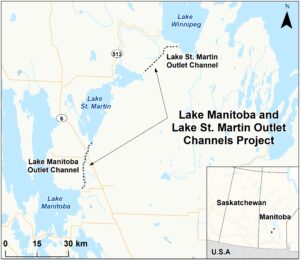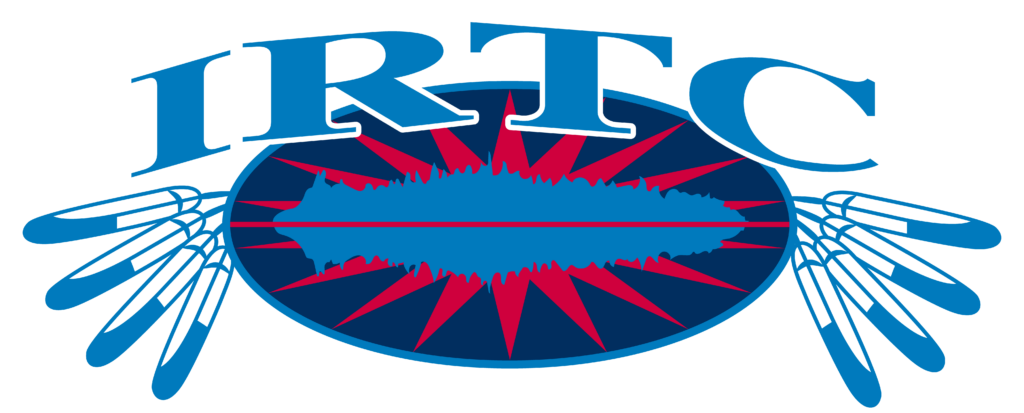The governments of Canada and Manitoba announced they will cost share up to $540million in new flood management infrastructure for Lake Manitoba and Lake St. Martin outlet channels as Manitoba Premier Brian Pallister and Jim Carr, Minister of Natural Resources Canada, on behalf of the Honourable Amarjeet Sohi, announced today.
Federal funding of $247.5 million will be provided for the Lake Manitoba and Lake St. Martin Outlet Channels Project, the first project to be funded under the recently launched Disaster Mitigation and Adaptation Fund. Manitoba will provide matching funds in the amount of $247.5 million, plus an additional $45 million in order to complete the project.
“After 60 years of inaction, we are proud to stand today alongside our partners in the federal government to announce this vital project,” says Pallister. “We are focused on completing this project in a timely fashion to better protect Manitobans who have sacrificed so much.”
The governments of Canada and Manitoba identified the channels project as a major priority, due to severe flooding in the area in 2011 and 2014. These disasters resulted in extensive damage to homes, businesses and infrastructure in the province, as well as emergency evacuations, particularly for communities around Lake St. Martin.
“The funding shows that the Government of Canada is taking concrete steps to protect the vulnerable communities around Lake Manitoba, and Lake St. Martin, from disasters like the 2011 and 2014 floods,” says Carr. “Mitigating the effects of natural hazards before they happen is critical to reducing the devastating social, personal and economic costs of recovering after the fact. With investments like these, we will make communities across Canada more resilient to climate change, and ensure residents and businesses can thrive for generations to come.”
During times of flooding and high-water levels on Lake Manitoba, the new outlet channel will carry water directly from Lake Manitoba to Lake St. Martin. The Fairford River is the natural outlet to Lake St. Martin and the new channel will move water directly to Lake Winnipeg. The Dauphin River is the natural outlet to Lake Winnipeg from Lake St. Martin.
The project consists of building two 23-kilometre-long diversion channels. The Lake Manitoba Outlet Channel will run north from Watchorn Bay on Lake Manitoba to Birch Bay on Lake St. Martin and the Lake St. Martin Outlet Channel will run northeast from Lake St. Martin to Lake Winnipeg south of Willow Point. The project also involves building two bridges and water control structures, a 24-kilovolt distribution line, and adjusting surrounding highway infrastructure.
The project will significantly reduce the flood damage experienced by First Nations located along Lake St. Martin, complementing other regional flood protection infrastructure to ensure a more comprehensive provincial water control network that enables the province to effectively manage flows from the Assiniboine River and Lake Manitoba watersheds spanning Manitoba, southeast Saskatchewan and northeast North Dakota. Together, the channels will allow Manitoba to regulate lake levels and provide flood protection to individuals, businesses, communities and farmland around Lake Manitoba and Lake St. Martin. Once completed, this work will significantly enhance the region’s ability to regulate water levels on both lakes and protect local Indigenous and non-Indigenous communities from flooding.
The new Lake Manitoba outlet channel is designed with a capacity of 7,500 cubic feet per second (cfs) and the Lake St. Martin channel will carry approximately 11,500 cfs at capacity. The current capacity of the Lake St. Martin Emergency Outlet Channel is approximately 4,000 cfs. The existing single Lake St. Martin emergency channel to Lake Winnipeg will be available on an emergency basis during construction. After the permanent channels are completed, the existing emergency channel will be modified for environmental support purposes, which are still being defined and developed.
The proposed channel alignments are a result of evaluating several options for each channel. Construction of an access road to the Lake St. Martin construction area is underway. The remainder of construction could start as soon as fall 2019.
The next phase of the Manitoba government’s proposed plans for the construction of the Lake Manitoba and Lake St. Martin outlet channels will be presented at a series of open house sessions, Infrastructure Minister Ron Schuler announced today.
“These are major flood management projects and will be as essential as the Red River Floodway and the Portage Diversion in provincial flood-fighting efforts,” said Schuler. “Manitoba is a collection point of major watersheds that start outside of the province but can result in widespread flooding, devastation, costly cleanup and years of restoration.”
Open house topics will include environmental approvals, design and construction, and the next steps in the delivery of this major flood infrastructure project. There will also be an opportunity to learn more about the operation of the Portage Diversion. The diversion moves Assiniboine River water north into Lake Manitoba during heavy spring flooding and unusual summer storms
An open house session is planned from 2-5 p.m. and 6-8 p.m. at the Canad Inns in Portage la Prairie on Thursday, June 21.
-Article Courtesy of Portage Online


